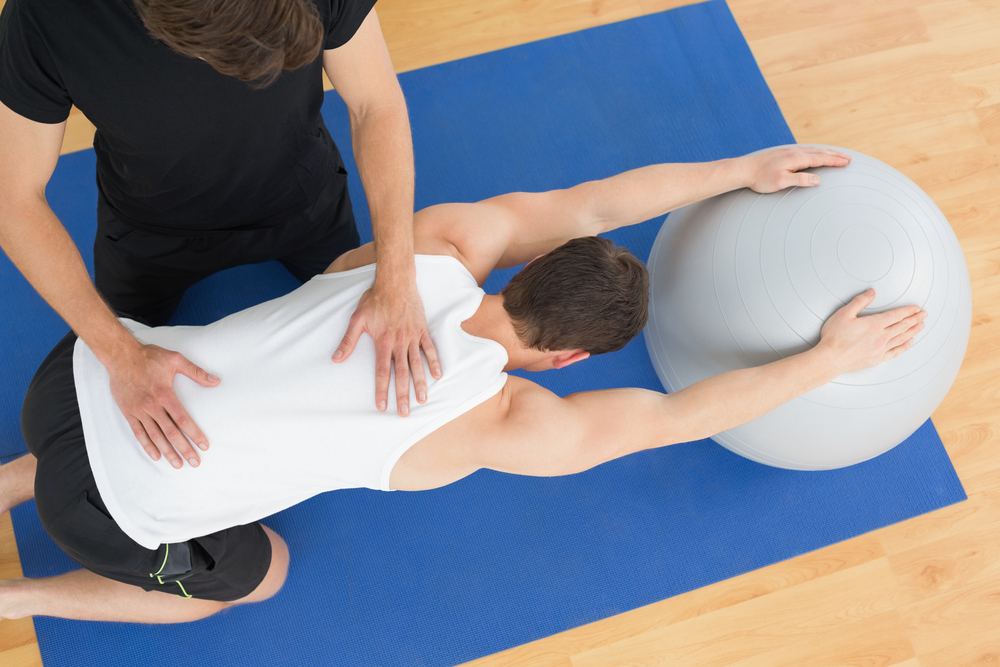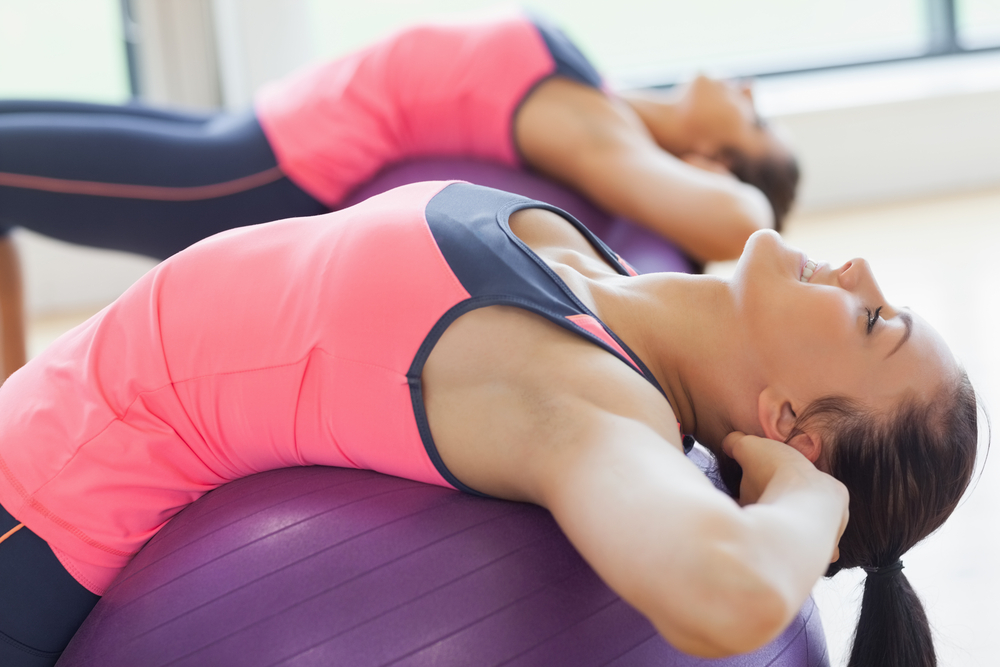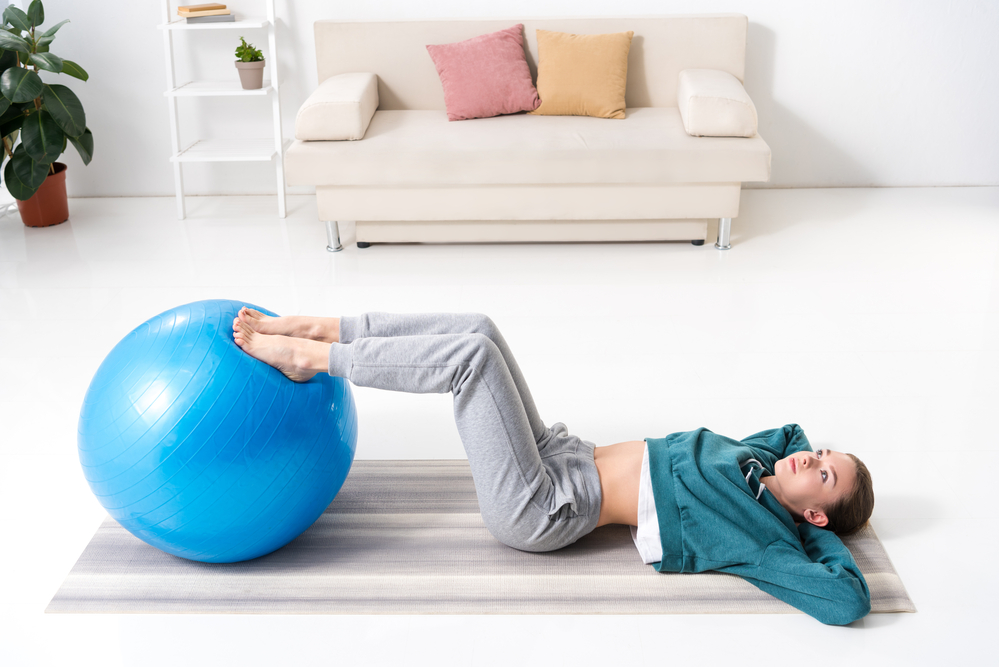As a yoga practitioner, you know how much yoga benefits your health and life. But if you’ve been practicing yoga for a while, you might be looking for a little variety in your techniques or ways to make them a bit more of a challenge.
One way to add more resistance and strength to your yoga practice is to add a yoga ball, also known as a stability ball.
Learn more about how you can incorporate it into your routine, and try some of these moves to get you started.
Contents
The Benefits of a Yoga Ball

If you thought yoga was full of benefits, wait until you start using an exercise ball. Adding this small element to your yoga or even pilates practice can improve your health in more ways than one.
Back and Spine Health
A ball workout can help if you suffer from back problems because it adds support to your lower back as you exercise.
Essentially, a fitness ball will take the pressure off your back and spine, allowing you to move easier and reduce your risk of low back injuries. That’s precisely why chiropractors and physical therapists use these in therapy.
Check out our yoga ball storage guide.
Core Stability and Strength
Your core muscles include:
- Transverse abdominis, which are the deep core abdominal muscles
- The tultifidus muscle that provides lumbar support
- Quadratus lumborum muscles that create spinal and pelvic balance
All of these muscle groups work together to help you with everyday activities like bending, lifting, reaching, walking, and running. They act as stabilizers that help your upper body avoid injuries to the back and spine.
Needless to say, having a strong core is one of the best things you can do for your help, and using an exercise ball can help you achieve this.
Improved Posture
Since balance balls help build core strength and stability, they also help you achieve good posture. A stability ball will help promote a natural slight spine curvature, which experts have recently realized is healthier than having a perfectly straight spine.
Muscle Balance
If you’ve never heard of muscle balance, you’re not alone. This isn’t always mentioned when it comes to core exercises, but it’s just as important as building strength.
If a muscle group is weaker than an opposing group, this creates a muscle imbalance. An excellent example of this would be if your triceps were stronger than your biceps.
Using a yoga ball can help you balance out your muscle groups’ strength since it engages your core while supporting your posterior muscles.
How to Use a Yoga Ball

Using a yoga ball is easy, but It’s important to find a yoga or fitness ball that accommodates your height and size. To get the right size, all you have to do is follow a simple rule of thumb.
The ball should create a perfect 90-degree angle in your legs when you sit up. If you are above or below this point, then you know the ball is the wrong size.
As with all new exercise methods or using equipment it’s always important to consult your doctor before you use a yoga ball.
Once you find a ball that fits you correctly, here are three basic yoga positions you can do with your ball.
1. Upward Facing Dog
This classic move can easily be enhanced with the use of a yoga ball.
- Place your ball on the mat and gently come down on your hands and knees with the ball in front of you.
- Continue moving forward until your hips are on the balls’ center, and your legs are straight behind you.
- Press your hands into the ball, push your chest up, and straighten your arms until they are above your head in an upward facing dog position.
2. Downward Facing Dog
You can easily transition into a downward-facing dog from the upward position.
- Exhale and slowly roll forward.
- Keep your hands on the floor and push your body up into an inverted v position.
- Keep your feet firmly planted on the ground and make sure your chest and upper thighs are supported on the yoga ball.
- Alternating between upward and downward dog for ten reps is an excellent way to stretch your back.
3. Seated Spinal Rotation
- Start by sitting up straight on your fitness ball. If you’re having trouble with stability, you can place your ball against a wall.
- Extend your legs in front of you.
- Flex your feet and hold your arms straight and to the side, so they are aligned with your shoulders.
- Twist your torso to the right so that your left arm is out and pointed towards your right foot.
- Come back to the center and reach for your toes, holding for a moment.
- Rotate towards the left, so the right arm is pointed towards your left foot. Repeat this movement ten times to get a good hamstring and core stretch.
Four Mistakes to Avoid With a Yoga Ball

As beneficial as a yoga ball is, there are some things to watch out for if you’re new to this method.
1. Choosing the Wrong Ball Size
As mentioned before, choosing the right ball size is imperative. If you have the wrong size ball, you won’t be able to fully engage your core or get the support your back muscles need, which could lead to injury.
2. Not Doing the Moves Correctly
If you’re starting with a yoga ball, it’s good to start slow or even work with a professional instructor so you can do the moves correctly. By moving through the movements too quickly or not doing them correctly, you will be putting yourself at risk of injury.
3. Feeling Unstable During Workouts
The point of a yoga ball is to build strength and stability in your core, so if you’re not feeling stable, something is amiss. If you need help getting started, keep your ball against a wall for support until you get to a point where you can do it alone.
4. Not Inflating the Ball Correctly
Not inflating your exercise ball correctly can directly lead to instability and affect how you do your moves. The best way to know your ball is fully inflated is to make sure it’s bouncy and firm.
The Final Word: Start Improving Your Core Strength and Stability with a Yoga Ball
Now that you know the benefits of a yoga ball and how to use one, it’s time to get one of your own. Once you add it to your yoga routine, you’ll see a noticeable difference and wonder why you didn’t start using one sooner!



